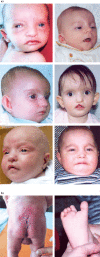Phenotypic variations in wolf-hirschhorn syndrome
- PMID: 25741211
- PMCID: PMC4347473
- DOI: 10.2478/bjmg-2014-0021
Phenotypic variations in wolf-hirschhorn syndrome
Abstract
Wolf-Hirschhorn syndrome (WHS) is a rare chromosomal disorder caused by terminal deletion of the short arm of chromosome 4. The clinical picture includes growth retardation, severe mental retardation, characteristic "Greek helmet" like face, seizures and midline defects in the brain, heart, palate and genitalia. Recently-used molecular techniques increase the number of diagnosed cases due to the detection of smaller deletions. The severity of the clinical presentation is variable depending on the haploinsufficiency of genes in a deleted region. We present six children with WHS with variable clinical appearance. The assessment of several elements (facial dysmorphism, mental retardation, additional congenital anomalies) provided classification into minor, mild or severe forms. Three of the children had a visible cytogenetic deletion on chromosome 4p, two had microdeletions detected with fluorescent in situ hybridization (FISH), and one child with a less characteristic clinical picture had a mosaic type of the deletion. Correlation between the clinical presentation and the length of the deleted region was confirmed.
Keywords: Fluorescent in situ hybridization (FISH); Microdeletion syndromes; Phenotype; Wolf-Hirschhorn syndrome (WHS).
Figures
Similar articles
-
Wolf-Hirschhorn Syndrome – RETIRED CHAPTER, FOR HISTORICAL REFERENCE ONLY.2002 Apr 29 [updated 2015 Aug 20]. In: Adam MP, Feldman J, Mirzaa GM, Pagon RA, Wallace SE, Amemiya A, editors. GeneReviews® [Internet]. Seattle (WA): University of Washington, Seattle; 1993–2025. 2002 Apr 29 [updated 2015 Aug 20]. In: Adam MP, Feldman J, Mirzaa GM, Pagon RA, Wallace SE, Amemiya A, editors. GeneReviews® [Internet]. Seattle (WA): University of Washington, Seattle; 1993–2025. PMID: 20301362 Free Books & Documents. Review.
-
From Wolf-Hirschhorn syndrome to NSD2 haploinsufficiency: a shifting paradigm through the description of a new case and a review of the literature.Ital J Pediatr. 2022 May 12;48(1):72. doi: 10.1186/s13052-022-01267-w. Ital J Pediatr. 2022. PMID: 35550183 Free PMC article. Review.
-
On the nosology and pathogenesis of Wolf-Hirschhorn syndrome: genotype-phenotype correlation analysis of 80 patients and literature review.Am J Med Genet C Semin Med Genet. 2008 Nov 15;148C(4):257-69. doi: 10.1002/ajmg.c.30190. Am J Med Genet C Semin Med Genet. 2008. PMID: 18932124 Review.
-
Microarray and FISH-based genotype-phenotype analysis of 22 Japanese patients with Wolf-Hirschhorn syndrome.Am J Med Genet A. 2014 Mar;164A(3):597-609. doi: 10.1002/ajmg.a.36308. Epub 2013 Dec 19. Am J Med Genet A. 2014. PMID: 24357569
-
Submicroscopic duplication of the Wolf-Hirschhorn critical region with a 4p terminal deletion.Cytogenet Genome Res. 2009;125(2):103-8. doi: 10.1159/000227833. Epub 2009 Aug 31. Cytogenet Genome Res. 2009. PMID: 19729912
Cited by
-
Wolf-Hirschhorn Syndrome with Hyperparathyroidism: A Case Report and a Narrative Review of the Literature.J Pediatr Genet. 2021 Jun 26;12(4):312-317. doi: 10.1055/s-0041-1729751. eCollection 2023 Dec. J Pediatr Genet. 2021. PMID: 38162156 Free PMC article.
-
Growth trajectory and pubertal tempo from birth till final height in a girl with Wolf-Hirschhorn syndrome.Endocrinol Diabetes Metab Case Rep. 2018 Apr 12;2018:18-0001. doi: 10.1530/EDM-18-0001. eCollection 2018. Endocrinol Diabetes Metab Case Rep. 2018. PMID: 29675261 Free PMC article.
-
Clinical and genetic characterization of ten Egyptian patients with Wolf-Hirschhorn syndrome and review of literature.Mol Genet Genomic Med. 2021 Feb;9(2):e1546. doi: 10.1002/mgg3.1546. Epub 2020 Nov 20. Mol Genet Genomic Med. 2021. PMID: 33217222 Free PMC article. Review.
-
Features of the Wolf-Hirschhorn Syndrome (WHS) from Infant to Young Teenager.Balkan J Med Genet. 2023 Jul 31;26(1):75-82. doi: 10.2478/bjmg-2023-0006. eCollection 2023 Jul. Balkan J Med Genet. 2023. PMID: 37576793 Free PMC article.
-
Prenatal phenotype of Wolf-Hirschhorn syndrome: A case series and literature review.Mol Genet Genomic Med. 2023 Jun;11(6):e2155. doi: 10.1002/mgg3.2155. Epub 2023 Feb 27. Mol Genet Genomic Med. 2023. PMID: 36849216 Free PMC article. Review.
References
-
- Cooper H, Hirschhorn K. Apparent deletion of short arms of one chromosome (4 or 5) in a child with defects of midline fusion. Hum Chrom Newsl. 1961;4(14):14–16. - PubMed
-
- Hirschhorn K, Cooper HL, Firschein IL. Deletion of short arms of chromosome 4–5 in a child with defects of midline fusion. Humangenetik. 1965;1(5):479–482. - PubMed
-
- Wolf H, Porsch R, Schroeter R, Baitsch H. Defizienz an den kurzen Arm eines Chromosoms nr. 4. Humangenetik. 1965;1(5):397–413. - PubMed
-
- Bergemann A, Cole F, Hircshhorn K. The etiology of Wolf-Hirschorn syndrome. Trends Genet. 2005;21(3):188–195. - PubMed
-
- Battaglia D, Zampino G, Zollino M, Mariotti P, Acquafondata C, Lettori D, et al. Electroclinical patterns and evolution of epilepsy in the 4p- syndrome. Epilepsia. 2003;44(9):1183–1190. - PubMed
LinkOut - more resources
Full Text Sources
Other Literature Sources



